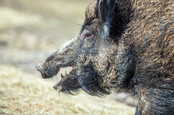A wasp nest positively glowing with radiation was found at a Cold War-era nuclear weapons site near Aiken, South Carolina.
A US Department of Energy report released last week casually dropped that a routine inspection had “discovered a wasp nest on a stanchion” near millions of gallons of liquid nuclear waste stored at Savannah River Site (SRS) that “was probing 100,000 disintegrations per minute/100 square centimeters beta/gamma.”
That’s ten times the level deemed safe by regulations.

Radioactive hybrid terror pigs have made themselves a home in Fukushima’s exclusion zone
READ MORE
The Radiological Control Operation investigators who found it didn’t seem worried, though. “The wasp nest was sprayed to kill wasps, then bagged as radiological waste,” they said. “The ground and surrounded area did not have any contamination.”
Nor was the nuclear nest the result of “a loss of contamination control,” the report stated, but was simply to be “considered onsite legacy radioactive contamination,” which is government-speak for “it’s the Soviet Union’s fault.”
Back in the 1950s, SRS was busy cooking up plutonium for bomb cores. These days, it’s more focused on manufacturing nuclear materials for power plants than mutually assured destruction.
Regrettably, the report makes no mention of puppy-sized hornets, wings humming like helicopter blades, menacing the operatives as though they were enemies from the Fallout series of video games. In fact, a statement provided to the Aiken Standard by Savannah River Mission Completion, which oversees the site, said “no wasps were found on the nest” and that “the individual insects would have significantly lower levels of contamination.”
“Upon discovery of the contaminated nest, the immediate area was secured and surveyed; no contamination was found in the area. There were no impacts to workers, the environment, or the public,” it continued.
“F Tank Farm is centrally located inside the 310-square-mile Savannah River Site. Generally, wasps travel only a few hundred yards from their nest.”
So that’s all right then? Watchdog group Savannah River Site Watch wasn’t exactly buzzing with satisfaction. It argued that the report was half-baked because it fails to explain where the radiation came from, how the wasps stumbled into it, or whether there might be more contaminated nests lurking out there if there’s a leak.
Knowing what kind of wasp built the nest could also be important, noted Tom Clements, the group’s executive director. Some wasps build with mud, others with plant fiber, and that choice of nesting material might point straight to the source of the contamination, he told the Associated Press.
“I’m as mad as a hornet that SRS didn’t explain where the radioactive waste came from or if there is some kind of leak from the waste tanks that the public should be aware of,” Clements said.
For context, the site has produced over 165 million gallons of liquid nuclear waste in its radioactive heyday, reduced to about 34 million gallons through evaporation, according to Savannah River Mission Completion. Forty-three of its underground tanks are still in active use, and eight have been retired – hopefully not just capped with duct tape and good intentions. ®
